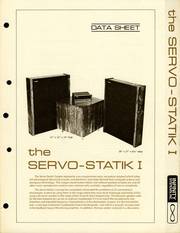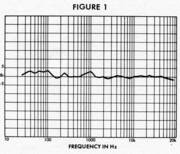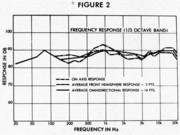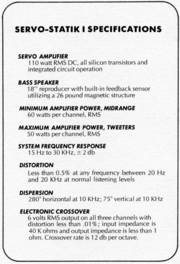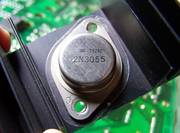Der deutsche Vertrieb Audio Int'l machte tolle Prospekte
Damals war fast überall Hochglanz angesagt und volle Farbenpracht war ein Muß. Außer bei Braun, dort hatte der Designer Dieter Rams zwar auch hochglanz - aber in schwarz weiß - vorgegeben. Und der damalige erste Infinity Vertrieb Audio Int'l. aus Frankfurt machte es noch anders, er nahm braunes grobgefasertes Papier und druckte dort ganz spartanisch - und damit besonders auffällig - mit zwei Farben, braun und schwarz drauf.
1974 - Die SERVO-STATIK I - Prospekt und Datenblatt zusammen
The Servo-Statik I System represents a no-compromise music recreation standard which takes full advantage of advanced acoustic and electronic principles derived from computer science and aerospace technology. This unique sound system totally and without question eclipses any and all other music reproduction systems now commercially available, regardless of size or complexity.
The Servo-Statik I concept has completely eliminated the problems of all conventional electrostatic screens by using them in the range where they truly excel (midrange and treble) while using a dynamic speaker in the range where it excels (bass frequencies). The dynamic speaker used for the bass frequencies can be no ordinary loudspeaker if it is to match the exceptionally low distortion and extended frequency characteristics of the electrostatic screens.
For this formidable task, a new type of dynamic loudspeaker had to be designed - one which is actually incorporated in the feedback loop of the driving amplifier. In addition, the bass system is placed in a decorative commode of moderate proportions which can be placed almost anywhere in the listening room due to the non-directional characteristics of bass frequencies of 100 Hz and below.
Thus, for the first time, it is possible to hear/feel the mighty 16 Hz organ pedal note and on the same system experience the delicate bowing of strings and the spectacular transients of plucked strings of chamber music.
The servo bass system employs a small sensing element on the voice coil of the loudspeaker. Since, at frequencies below 100 Hz, the cone acts virtually like a perfect piston, the output signal from the sensor corresponds exactly to the motion of the loudspeaker itself. The signal recorded in the sensor is proportional to the motion of the loudspeaker; furthermore, all distortions obtained in this moving system are clearly present in the electrical signal obtained from the sensor.
This signal, then, is a precise measure of how the output of the loudspeaker system deviates from the driving signal of the power amplifier. It is this signal that is fed back into the input of the amplifier which ultimately drives the speaker into a region of uniform response and low distortion not possible without employing the feedback principle.
For this application a special 18" loudspeaker (16" piston) is utilized, which includes the small sensor in the moving system. This speaker is capable of 3/4" peak-to-peak motion with the sensor remaining linear. In order to appreciate the acoustical power output capabilities of this speaker, one needs only to be aware of the fact that a 16" piston which moves 3/4" peak-to-peak at a frequency of 35 Hz is delivering one full acoustic watt of power!
This is enough power at 35 Hz to fill an enormous living room if not a small auditorium. The speaker is housed in a four cubic foot box of extremely sturdy construction and is filled with sound absorbing material.
The amplifier which drives the bass system is a 110 watt RMS DC amplifier capable of peak powers in excess of 200 watts. It utilizes all-silicon transistors and computer grade components including an integrated circuit operational amplifier at the front end and advanced complementary symmetry circuitry throughout. The amplifier also has contained within it an electronic crossover which correctly feeds the bass system and screens with the proper frequency spectrum.
The peerless sound quality of the electrostatic transducer arises principally because of three factors:
1) the extremely low mass of the moving system;
2) the driving force is distributed uniformly over the moving diaphragm area, and;
3) constant energy output as a function of frequency.
The diaphragm of an electrostatic reproducer is of low mass because it is extremely thin, approximately .0005" in thickness. The low mass gives the screen excellent transient response since the diaphragm can be accelerated very rapidly (due to the small inertial mass) while the resistance of the air load damps out any overshoot. Moreover, the low mass of the tweeter diaphragm (.00025 inch in thickness) can give flat frequency response up to and beyond 30 KHz.
High frequency rolloff occurs when the mass of the diaphragm is equal to the mass reactance of the air load in front of the diaphragm. This occurs at about 30 KHz in the Servo-Statik I System, after which the response drops off at 6 db per octave.
The fact that the electrostatic screen utilizes a uniform electric driving force over its entire radiating area serves to virtually eliminate what is called "cone-breakup" (one of the principal factors which produce distortion in conventional loudspeakers, caused by the cone being driven only at its center).
In most instances, distortion in screens never exceeds 0.5%. The Infinity systems' electrostatic speakers differ in design from most conventional units.
- First, they are designed for exceptionally high-power handling capacity and therefore can handle most amplifiers fed into them (there are no fuses in series with the speaker line).
- Second, the grids on either side of the diaphragm are highly conductive rather than highly resistive; thereby giving constant power output at all frequencies and exceptional articulation.
- Finally, the dispersion characteristics of the screens are vastly different than most electrostatics. The Servo-Statik I System has eliminated the dispersion problems of conventional units by utilizing narrow strip tweeters and compound angled midrange modules which results in flat frequency response on or off axis.
Additionally, the screens radiate 50% of their energy in the rear direction, adding the correct amount of reflected sound in the room and resulting in concert hall realism and smoothness.
SERVO-STATIK I SPECIFICATIONS
SERVO AMPLIFIER
110 watt RMS DC, all silicon transistors and integrated circuit operation
BASS SPEAKER
18" reproducer with built-in feedback sensor utilizing a 26 pound magnetic structure
MINIMUM AMPLIFIER POWER, MIDRANGE
60 watts per channel, RMS
MAXIMUM AMPLIFIER POWER, TWEETERS
50 watts per channel, RMS
SYSTEM FREQUENCY RESPONSE
15Hz to 30KHz, ±2db
DISTORTION
Less than 0.5% at any frequency between 20 Hz and 20 KHz at normal listening levels
DISPERSION
280° horizontal at 10 KHz; 75° vertical at 10 KHz
ELECTRONIC CROSSOVER
6 volts RMS output on all three channels with distortion less than .01%; input impedance is 40 K ohms and output impedance is less than 1 ohm. Crossover rate is 12 db per octave.
Anmerkung des Autors gr zu dem Thema in 2010
Die angegebenen Specs sind natürlich nur "ideell" gemeint. In Natura stimmt da Einiges nicht. Die Mono-Bass-Endstufe mit den beiden 2N3055 und der gemessenen Versorgungsspannung des Verstärkers kann physikalisch maximal 70 Watt Sinus ergeben. Die Transistoren vom Typ 2N3055 waren noch die beiden Originale und von der billigsten Sorte !!. Der Verstärker mußte ja nur Frequenzen von maximal 140Hz bis herunter zu 30Hz liefern und der Rückkopplungs- Regelkreis benötigte damit die maximale Regelgeschwindig- keit von 2 Kilohertz, um die Korrekturen im Bass zu verarbeiten.
Alle End-Verstärker an den Mittel- oder Hochton-Einheiten der SS1, die nicht impedanz-stabil für kapazitive Lasten waren, erzeugten leider klägliche Ergebnisse. Unsere damaligen Versuche mit dünnen und dicken SAE Endstufen versagten alle. Alleine der Crown DC150 und der DC300A mit seinen 2 x 190 Watt an 8 Ohm (und 2 x 300 Watt an 4 Ohm) waren in der Lage, die kapazitive Last der jeweils 4 elektrostatischen Hochtöner und der 4 elektrostatischen Mitteltöner zu schultern. Wir haben damals Impedanzen von um die 2 Ohm gemessen.
Und unter 150 Watt stabiler Sinusleistung tat sich im Mitteltonbereich auch nicht viel. Alleine die Hochtöner wären mit stabilen 30 Watt wirklich zufrieden gewesen.
Klirrfaktor-Tests konnten wir damals nicht machen - wir wußten gar nicht, wie das gehen sollte und der Abstrahlwinkel war bei fanatischen Hifi-Freaks nie ein Thema.
Die Frequenzweiche war wirklich eine Garagenkonstruktion von 1968, über die wir zuerst nur gestaunt und später dann nur noch gelächelt hatten. - Also nichts mit "Computer Grade Components" - wie versprochen. Es war billige Hardware.
Dennoch hatte die ganze Welt - also nicht nur ich selbst und meine Gäste - gestaunt, wie toll Musik auf einmal klingen konnte und das lange vor der CD oder vor PCM.
.

